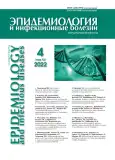Development of a procedure for ranking the administrative territories in the constituent entities of the Russian Federation according to the degree of risk for complicating the epizootiological and epidemiological situation of anthrax on the basis of multivariate analysis
- Authors: Logvin F.V.1, Kulichenko A.N.2, Buravtseva N.P.2, Ryazanova A.G.2, Gerasimenko D.K.2, Chmerenko D.K.2, Mezentsev V.M.2, Dubyansky V.M.2, Aksenova L.Y.2, Semenova O.V.2, Golovinskaya T.M.2
-
Affiliations:
- Rostov State Medical University, Ministry of Health of Russia
- Stavropol Plague Control Research Institute, Russian Federal Service for Supervision of Consumer Rights Protection and Human WellBeing
- Issue: Vol 12, No 4 (2022)
- Pages: 26-33
- Section: Articles
- Published: 15.04.2022
- URL: https://journals.eco-vector.com/2226-6976/article/view/287977
- DOI: https://doi.org/10.18565/epidem.2022.12.3.26-33
- ID: 287977
Cite item
Abstract
Full Text
About the authors
Fedor V. Logvin
Rostov State Medical University, Ministry of Health of Russia
Email: atlz3@mail.ru
Cand. Med. Sci., Associate Professor
Aleksandr N. Kulichenko
Stavropol Plague Control Research Institute, Russian Federal Service for Supervision of Consumer Rights Protection and Human WellBeing
Email: stavnipchi@mail.ru
Corresponding Member of the Russian Academy of Sciences, MD, Director
Nina P. Buravtseva
Stavropol Plague Control Research Institute, Russian Federal Service for Supervision of Consumer Rights Protection and Human WellBeingMD, Principal Researcher
Alla G. Ryazanova
Stavropol Plague Control Research Institute, Russian Federal Service for Supervision of Consumer Rights Protection and Human WellBeingCand. Med. Sci., Bacteriologist, Head, Anthrax Laboratory
Diana K. Gerasimenko
Stavropol Plague Control Research Institute, Russian Federal Service for Supervision of Consumer Rights Protection and Human WellBeing
Email: diana-gerasimenko-95@mail.ru
Biologist
Dmitry K. Chmerenko
Stavropol Plague Control Research Institute, Russian Federal Service for Supervision of Consumer Rights Protection and Human WellBeing
Email: dmitry.tchmerenko@yandex.ru
Junior Researcher
Vladimir M. Mezentsev
Stavropol Plague Control Research Institute, Russian Federal Service for Supervision of Consumer Rights Protection and Human WellBeing
Email: vladmez@inbox.ru
Cand. Med. Sci., Epidemiologist
Vladimir M. Dubyansky
Stavropol Plague Control Research Institute, Russian Federal Service for Supervision of Consumer Rights Protection and Human WellBeing
Email: dvmplague@gmail.com
BD, Head, Department of Epizootiological Monitoring and Forecasting
Lyudmila Yu. Aksenova
Stavropol Plague Control Research Institute, Russian Federal Service for Supervision of Consumer Rights Protection and Human WellBeingCand. Med. Sci., Senior Researcher
Olga V. Semenova
Stavropol Plague Control Research Institute, Russian Federal Service for Supervision of Consumer Rights Protection and Human WellBeingCand. Biol. Sci., Researcher
Tatiana M. Golovinskaya
Stavropol Plague Control Research Institute, Russian Federal Service for Supervision of Consumer Rights Protection and Human WellBeingCand. Biol. Sci., Biologist
References
- Логвин Ф.В., Кондратенко Т.А., Водяницкая С.Ю. Сибирская язва в мире, странах СНГ и Российской Федерации (обзор литературы). Медицинский вестник Юга России 2017; 8(3): 17-22. doi: 10.21886/2219-80752017-8-3-17-22
- Дугаржапова З.Ф., Чеснокова М.В., Гольдапель Э.Г., Косилко С.А., Иннокентьева Т.И., Балахонов С.В. Сибирская язва в азиатской части Российской Федерации. Сообщение 1. Исторические сведения о распространенности болезни в Сибири и на Дальнем Востоке. Проблемы особо опасных инфекций 2017; (1): 54-8. doi: 10.21055/0370-1069-2017-1-54-58
- Попова А.Ю., Ежлова Е.Б., Демина Ю.В., Куличенко А.Н., Рязанова А.Г., Буравцева Н.П. и др. Пути совершенствования эпидемиологического надзора и контроля за сибирской язвой в Российской Федерации. Проблемы особо опасных инфекций 2017; (1): 84-8. doi: 10.21055/03701069-2017-1-84-88
- Попова А.Ю., Куличенко А.Н. (ред). Опыт ликвидации вспышки сибирской язвы на Ямале в 2016 году. Ижевск: ООО «Принт-2», 2017. 313 с
- Горячева Н.Г., Авитисов П.В., Семиног В.В., Глотов Е.Н. Развитие мониторинга биологических угроз почвенных очагов сибирской язвы Научные и образовательные проблемы гражданской защиты 2016; 28(1): 41-6
- Черкасский Б.Л. Эпидемиология и профилактика сибирской язвы. М.: ИНТЕРСЭН, 2002. 384 с
- Раичич С.Р., Сабурова С.А., Шабейкин А.А., Симонова Е.Г. Оценка ситуации по сибирской язве на основе ранжирования территорий по степени риска. Проблемы особо опасных инфекций 2020; (4): 125-32. doi: 10.21055/0370-10692020-4-125-132
- Логвин Ф.В., Кондратенко Т.А., Водяницкая С.Ю., Рыжова А.А., Водопьянов А.С., Жилин В.Г. и др. Результаты комплексной оценки территории Ростовской области по сибирской язве по степени эпизоотолого-эпидемиологической опасности. Медицинский вестник Юга России 2017; 8(4): 93-8. doi: 10.21886/2219-8075-2017-8-4-93-98
- Буравцева Н.П., Антюганов С.Н., Семенко О.В., Рязанова А.Г., Еременко Е.И., Куличенко А.Н. и др. Эпизоотолого-эпидемиологическое районирование территории Северо-Кавказского федерального округа по степени неблагополучия по сибирской язве с использованием программы Arc GIS10. Журнал микробиологии, эпидемиологии и иммунобиологии 2016; (3): 19-24. doi: 10.36233/0372-9311-2016-3-19-24
- Дугаржапова З.Ф., Ивачева М.А., Чеснокова М.В., Кравец Е.В., Решетняк Е.А., Уманец А.А. и др. Сибирская язва в Приморском крае (1919-2020 гг.). Сообщение 2. Эпизоотолого-эпидемиологическая ситуация и районирование административных территорий. Проблемы особо опасных инфекций 2021; (4): 67-78. doi: 10.21055/0370-1069-2021 4-67-78
- Симонова Е.Г., Раичич С.Р., Картавая С.А., Локтионова М.Н., Шабейкин А.А. Проявления активности стационарно неблагополучных по сибирской язве пунктов Российской Федерации в современных условиях. Проблемы особо опасных инфекций 2018; (2): 90-94. doi: 10.21055/0370-1069-2018-2-90-94
- Водопьянов А.С., Водяницкая С.Ю., Логвин Ф.В., Баташев В.В., Водопьянов С.О., Олейников И.П. и др. Использование ГИС-технологий на основе пространственного анализа для разработки методики риск-ориентированной оценки потенциальной опасности территорий по сибирской язве в Ростовской области. Медицинский вестник Юга России 2016; (3): 46-50. doi: 10.21886/2219-8075-2016-3-46-50
- Симонова Е.Г., Локтионова М.Н., Картавая С.А., Хадарцев О.С. Сибирская язва: оценка эпизоотолого-эпидемиологического риска в Российской Федерации на современном этапе. Эпидемиология и вакцинопрофилактика 2013; 69(2): 5-11
- Базарова Г.Х., Лукьяненко Н.В., Рождественский Е.Н., Салдан И.П., Шевченко В.В. Характеристика стационарно неблагополучных по сибирской язве пунктов на современном этапе развития в Алтайском крае. Проблемы особо опасных инфекций 2017; (2): 9-12
- Мицаев Ш.Ш. Сибирская язва в Чеченской Республике. Махачкала: АЛЕФ (ИП Овчинников М.А.), 2016. 182 с. Micaev Sh.Sh
- Определение эпидемиологической опасности почвенных очагов сибирской язвы. Методические рекомендации МР 3.1.0232-21 https://www.garant.ru/products/ipo/prime/doc/400555146/
- Урбах В.Ю. Биометрические методы. М.: Наука, 1964. 405 с
- Гланц С. Медико-биологическая статистика. М.: Практика, 1999. 459 с
- Черкасский Б.Л., Форстман Д.В., Локтионова М.Н., Шабейкин А.А. Опыт использования ГИС-технологий для изучения закономерностей распределения стационарно неблагополучных по сибирской язве пунктов. Эпидемиология и инфекционные болезни 2005; (6): 19-23
Supplementary files





